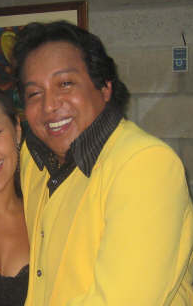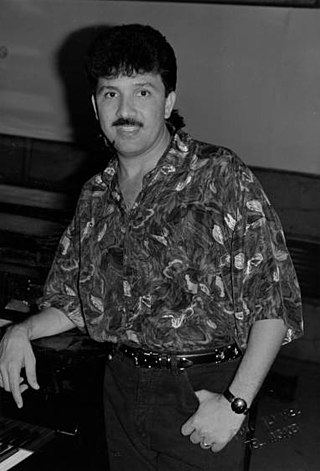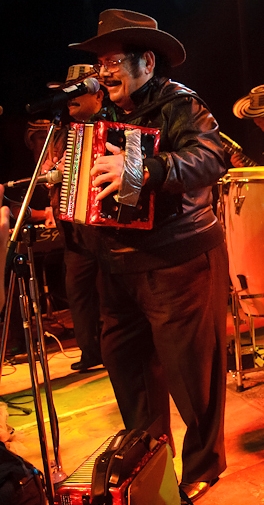
Valledupar is a city and municipality in northeastern Colombia. It is the capital of Cesar Department. Its name, Valle de Upar, was established in honor of the Amerindian cacique who ruled the valley; Cacique Upar. The city lies between the mountains of the Sierra Nevada de Santa Marta and the Serranía del Perijá to the borders of the Guatapurí and Cesar rivers.

Vallenato is a popular folk music genre from Colombia. It primarily comes from its Caribbean region. Vallenato literally means "born in the valley". The valley influencing this name is located between the Sierra Nevada de Santa Marta and the Serranía de Perijá in north-east Colombia. The name also applies to the people from the city where this genre originated: Valledupar. In 2006, vallenato and cumbia were added as a category in the Latin Grammy Awards. Colombia's traditional vallenato music is Intangible Cultural Heritage in Need of Urgent Safeguarding, according to UNESCO.

Canal 13 is a Chilean free-to-air television network. Informally known in Chile as El 13, it is the second oldest television station in the country. Launched on August 21, 1959, on VHF channel 2 in Santiago, it was founded by a group of engineers from the Pontifical Catholic University of Chile. The station later moved its frequency to VHF channel 13, which gave rise to its current name. One of its most significant milestones was broadcasting the 1962 FIFA World Cup, which was hosted in Chile.

Sincelejo is the capital and largest city of the Colombian department of Sucre in the Caribbean region. It is also the capital of the department's subregion, Sabanas, and is the 25th largest city by population of the country. It is located 30 kilometers from the Caribbean Sea at the Gulf of Morrosquillo, 125 kilometers from Cartagena, and 200 kilometers from Barranquilla.

Diomedes Díaz Maestre was a Colombian vallenato singer, songwriter, and composer. He has been named the "King of Vallenato" and is nicknamed El Cacique de La Junta, which was given to him by another vallenato singer, Rafael Orozco Maestre, in honor of Díaz's birthplace.

Rafael Calixto Escalona Martinez was a Colombian composer and troubadour. He was known for being one of the most prominent vallenato music composers and troubadours of the genre and for being the co-founder of the Vallenato Legend Festival, along with Consuelo Araújo and Alfonso López Michelsen.
Consuelo Inés Araújo Noguera, also known as "La Cacica", was a Colombian politician, writer and self-taught journalist. Her nickname was given by a fellow journalist colleague for her tenacity and determination to achieve goals and leadership.

The Caribbean region of Colombia or Caribbean coast region is in the north of Colombia and is mainly composed of 8 departments located contiguous to the Caribbean. It's the second most populated region in the country after Andean Region with approximately 11 million residents according to the Colombian Census 2018. The area covers a total land area of 110,000 km2 (42,000 sq mi), including the Archipelago of San Andrés, Providencia and Santa Catalina in the Caribbean Sea.

Rafael José Orozco Maestre was a Colombian singer of vallenato music. He was one of the major representatives of Colombian popular folk music and was lead singer and co-founder, alongside fellow accordionist Israel Romero, of the vallenato group Binomio de Oro de América, which was very popular in Colombia, Mexico and Venezuela.

La Guajira is a department of Colombia. It occupies most of the Guajira Peninsula in the northeast region of the country, on the Caribbean Sea and bordering Venezuela, at the northernmost tip of South America. The capital city of the department is Riohacha.

Mass media in Colombia refers to Mass media available in Colombia consisting of several different types of communications media: television, radio, cinema, newspapers, magazines, and Internet-based Web sites. Colombia also has a national music industry.

Television in Colombia or Colombian television is a media of Colombia. It is characterized for broadcasting telenovelas, series, game shows and TV news. Until 1998 it was a state monopoly. There are two privately owned TV networks and three state-owned TV networks with national coverage, as well as six regional TV networks and dozens of local TV stations. There are numerous cable TV companies operating in Colombia under each Colombian department statutes. These cable companies also develop their own channels, in addition to a variety of international channels. Television in Colombia has always relied on technological advancements from developed countries importing almost all the equipment.
Television in Spain was introduced in 1956, when the national state-owned public service television broadcaster Televisión Española (TVE) started regular analog free-to-air terrestrial black and white broadcasts. Colour transmissions started in 1972 after two years of test transmissions, with all programming transmitted in color in 1977, and colour commercials starting in 1978. TVE held a monopoly on television broadcasting until regional public channels were launched during the 1980s and commercial television started nationwide in 1990. Digital terrestrial television was launched on 30 November 2005 with analog service discontinued on 3 April 2010. Currently, television is one of the leading mass media of the country, and by 2008 was in 99.7% of households in Spain according to INE statistics.

Abel González Chávez was a Colombian radio/television host. From 1996 to 2019, González hosted a daily radio program on Emisora Atlántico called Satélite.

Ernesto McCausland Sojo was a Colombian journalist, writer and filmmaker.
Tele 9 Corazón was a Colombian local state-run television channel, whose signal only reached Bogotá and was broadcast on Channel 9. It replaced privately owned Teletigre.

Jéssica Annais de la Peña Camargo is a Colombian television presenter and journalist.

La Cacica, is a Colombia telenovela that premiered on Venezuelan broadcast television channel Televen on September 4, 2017, and concluded on October 30, 2017. The telenovela is based on the life on the Colombian writer and politics Consuelo Araújo Noguera. It stars Viña Machado as the titular character.

Aníbal Velásquez Hurtado is a Colombian singer, composer and musician, recognized for playing the accordion. He is also known by his nicknames "El Mago" and "El Rey de la Guaracha".

The Joe, the leyend is a 119-episode Colombian television biopic. It is inspired by the life and works of singer Joe Arroyo. Jair Romero starred as Joe Arroyo. Mauro Castillo and Estefanía Borges also starred as Wilson Manyoma and Jacqueline Ramón, respectively. Produced by Guillermo Restrepo, the TV show was a RCN Televisión production. It was originally broadcast from 30 May to 20 December 2011.
















